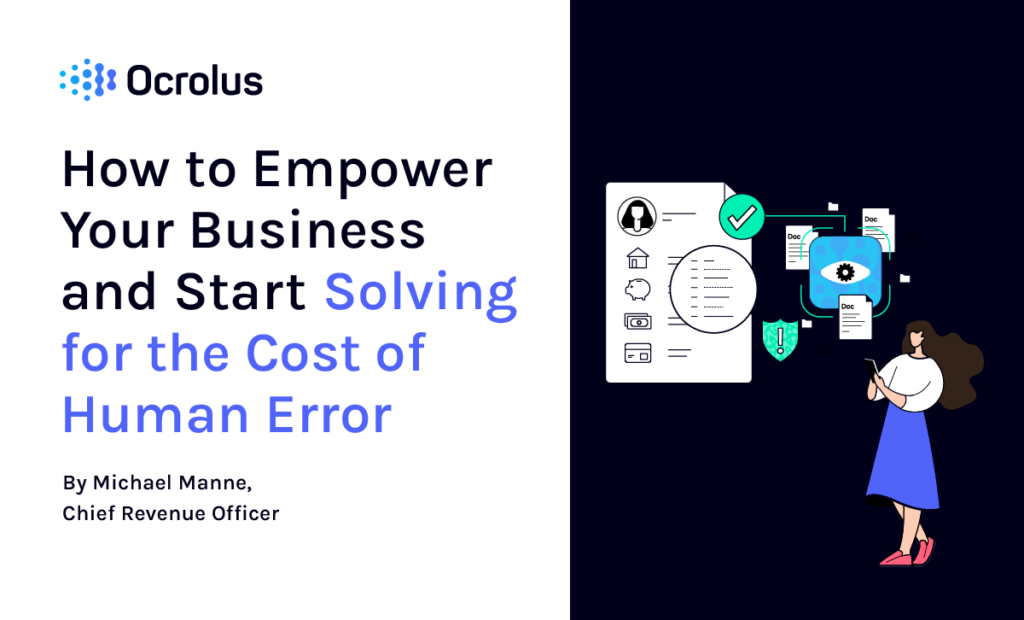Start Solving for the Cost of Human Error and Empower Your Business

It’s only human to make mistakes. Unfortunately, human error takes its toll on businesses – to the tune of trillions of dollars each year. Luckily, automation can actually help you start solving for the cost of human error and avoid these losses.
One of the biggest bank blunders and human error examples in recent memory occurred last summer when a clerical error resulted in $900 million being “accidentally” dispersed by Citibank. Consequently, as NPR reported, the bank had to try to claw back the lost funds.
While Citi had plenty of weight to throw around in trying to recoup the funds, the emergence of tech-savvy fintechs is changing the power dynamics for big banks. Katherine Doherty from Bloomberg News noted that the marketplace is changing. “In the past couple of decades, the whole financial system has gotten way more fractured,” she said. “A smaller percentage of money is flowing through those old, big-time banks now.”
The Cost of Human Error
The risk of human error rises as financial institutions handle more transactions. Bad data alone costs U.S. businesses more than $3.1 trillion a year, according to a report from IBM.
Human error in the financial services sector runs the gamut from accidental “reply all” emails and coding errors to mistakes in data entry and security breaches that give bad actors access to sensitive information. According to one report, the average employee makes 118 mistakes a year.
Costs are just one measure of the impact of human error. While not all mistakes are like Citi’s $900 million blunder, even small errors can impact the bottom line. Social media can add to the financial pain by amplifying the mistakes, potentially tarnishing a bank’s reputation. Trust has always been important when it comes to money matters, but it is even more vital when customers are relying on a rock-solid firewall to keep their account and financial details safe.
Financial institutions are already fighting an uphill battle when it comes to trust, and highly visible mistakes can make matters worse. For example, in a recent study by the Reputation Institute, only two of 40 large financial institutions were ranked as “excellent.” Even more telling, from one year to the next, more than 50% of the 40 banks saw their reputation ratings decline.
AI and Automation Reduce Risk
Human error is part of the cost of doing business, but automated systems powered by artificial intelligence can help financial institutions detect mistakes before they require costly intervention.
One of the keys to reducing human error is the use of human-in-the-loop automation (HITL) systems. With a HITL system, human experts validate a machine learning model on the fly. Financial institutions interested in reducing risk can use AI and automation to analyze financial documents and data streams. This is a state-of-the-art, real-time analysis that combines machine learning with human review.
The combination of AI analysis and automation with human insight with human insight facilitates good decision-making. Automation can, for example, be used to analyze bank statements, pay stubs, photo ids, and other key documents used for loan underwriting. Companies such as Plaid and PayPal are using human-in-the-loop technology in order to make faster, smarter decisions – reducing the likelihood of human error.
Intelligent automation, now a mainstay of the financial ecosystem, is getting more efficient thanks to AI and automation. One study, conducted by the University of Nevada-Las Vegas, found that human-powered automation technology is over 20-times more accurate than old-school manual verification.
Better Accuracy, Fewer Errors with Artificial Intelligence and Automation
Today, refined machine learning algorithms are routinely used by financial institutions to either replace or complement manual processes. In addition to ensuring more accurate document and data processing, automation helps financial institutions reduce risks and improve efficiency. The automation of tasks such as cash flow analytics and document fraud detection not only minimizes errors, it frees up personnel to focus on more value-added strategic responsibilities. According to a McKinsey report, AI can potentially unlock $1 trillion of incremental value for banks.
AI and workflow automation go hand in hand in the analysis of everything – from revenue and income to financial ratios and trends. Lenders can now use the power of automated analytics to build predictive risk models that outperform existing credit evaluation metrics. Machine learning systems also can be used to identify fraud and flag transactions for deeper human scrutiny. That translates into less risk and smarter decisions.
Automation enables financial institutions to reduce overhead costs while improving security and efficiency. Machine learning, combined with human-in-the-loop review, improves business productivity and helps to increase margins while delivering friction-free customer experiences. Essentially, any business can start solving for the cost of human error with a little help from AI and automation.
Ocrolus uses HITL machine learning to train models for identifying document types, data fields, and the actual data. To learn more about how Ocrolus can help automate your processes and start reducing error, you can schedule a demo today.


